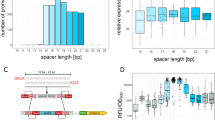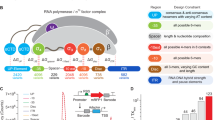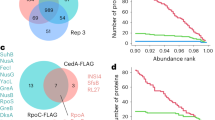Abstract
Bacterial transcription is controlled by sigma factors, the RNA polymerase subunits that act as initiation factors. Although a single housekeeping sigma factor enables transcription from thousands of promoters, environmentally induced sigma factors redirect gene expression toward small regulons to carry out focused responses. Using structural and functional analyses, we determined the molecular basis of −10 promoter element recognition by Escherichia coli σE, which revealed an unprecedented way to achieve promoter melting. Group IV sigma factors induced strand separation at the −10 element by flipping out a single nucleotide from the nontemplate-strand DNA base stack. Unambiguous selection of this critical base was driven by a dynamic protein loop, which can be substituted to modify specificity of promoter recognition. This mechanism of promoter melting explains the increased promoter-selection stringency of environmentally induced sigma factors.
This is a preview of subscription content, access via your institution
Access options
Subscribe to this journal
Receive 12 print issues and online access
$189.00 per year
only $15.75 per issue
Buy this article
- Purchase on Springer Link
- Instant access to full article PDF
Prices may be subject to local taxes which are calculated during checkout






Similar content being viewed by others
References
Paget, M.S. & Helmann, J.D. The sigma70 family of sigma factors. Genome Biol. 4, 203 (2003).
Gruber, T.M. & Gross, C.A. Multiple sigma subunits and the partitioning of bacterial transcription space. Annu. Rev. Microbiol. 57, 441–466 (2003).
Koo, B.M., Rhodius, V.A., Nonaka, G., deHaseth, P.L. & Gross, C.A. Reduced capacity of alternative sigmas to melt promoters ensures stringent promoter recognition. Genes Dev. 23, 2426–2436 (2009).
Feklistov, A. & Darst, S.A. Promoter recognition by bacterial alternative sigma factors: the price of high selectivity? Genes Dev. 23, 2371–2375 (2009).
Lonetto, M., Gribskov, M. & Gross, C.A. The sigma 70 family: sequence conservation and evolutionary relationships. J. Bacteriol. 174, 3843–3849 (1992).
Campbell, E.A. et al. Structure of the bacterial RNA polymerase promoter specificity sigma subunit. Mol. Cell 9, 527–539 (2002).
Young, B.A., Gruber, T.M. & Gross, C.A. Views of transcription initiation. Cell 109, 417–420 (2002).
Murakami, K.S. & Darst, S.A. Bacterial RNA polymerases: the wholo story. Curr. Opin. Struct. Biol. 13, 31–39 (2003).
Hook–Barnard, I.G. & Hinton, D.M. Transcription initiation by mix and match elements: flexibility for polymerase binding to bacterial promoters. Gene Regul. Syst. Bio. 1, 275–293 (2007).
Saecker, R.M., Record, M.T. Jr. & Dehaseth, P.L. Mechanism of bacterial transcription initiation: RNA polymerase – promoter binding, isomerization to initiation–competent open complexes, and initiation of RNA synthesis. J. Mol. Biol. 412, 754–771 (2011).
Shultzaberger, R.K., Chen, Z., Lewis, K.A. & Schneider, T.D. Anatomy of Escherichia coli sigma70 promoters. Nucleic Acids Res. 35, 771–788 (2007).
deHaseth, P.L., Zupancic, M.L. & Record, M.T. Jr. RNA polymerase–promoter interactions: the comings and goings of RNA polymerase. J. Bacteriol. 180, 3019–3025 (1998).
Feklistov, A. & Darst, S.A. Structural basis for promoter–10 element recognition by the bacterial RNA polymerase sigma subunit. Cell 147, 1257–1269 (2011).
Zhang, Y. et al. Structural basis of transcription initiation. Science 338, 1076–1080 (2012).
Feklistov, A. RNA polymerase: in search of promoters. Ann. NY Acad. Sci. 1293, 25–32 (2013).
Feklistov, A. et al. A basal promoter element recognized by free RNA polymerase sigma subunit determines promoter recognition by RNA polymerase holoenzyme. Mol. Cell 23, 97–107 (2006).
Roberts, C.W. & Roberts, J.W. Base–specific recognition of the nontemplate strand of promoter DNA by E. coli RNA polymerase. Cell 86, 495–501 (1996).
Marr, M.T. & Roberts, J.W. Promoter recognition as measured by binding of polymerase to nontemplate strand oligonucleotide. Science 276, 1258–1260 (1997).
Lim, H.M., Lee, H.J., Roy, S. & Adhya, S.A. “master” in base unpairing during isomerization of a promoter upon RNA polymerase binding. Proc. Natl. Acad. Sci. USA 98, 14849–14852 (2001).
deHaseth, P.L. & Helmann, J.D. Open complex formation by Escherichia coli RNA polymerase: the mechanism of polymerase–induced strand separation of double helical DNA. Mol. Microbiol. 16, 817–824 (1995).
Juang, Y.L. & Helmann, J.D. A promoter melting region in the primary sigma factor of Bacillus subtilis. Identification of functionally important aromatic amino acids. J. Mol. Biol. 235, 1470–1488 (1994).
Browning, D.F. & Busby, S.J. The regulation of bacterial transcription initiation. Nat. Rev. Microbiol. 2, 57–65 (2004).
Helmann, J.D. The extracytoplasmic function (ECF) sigma factors. Adv. Microb. Physiol. 46, 47–110 (2002).
Mascher, T. Signaling diversity and evolution of extracytoplasmic function (ECF) sigma factors. Curr. Opin. Microbiol. 16, 148–155 (2013).
Brown, K.L. & Hughes, K.T. The role of anti–sigma factors in gene regulation. Mol. Microbiol. 16, 397–404 (1995).
Helmann, J.D. Anti–sigma factors. Curr. Opin. Microbiol. 2, 135–141 (1999).
Campbell, E.A., Westblade, L.F. & Darst, S.A. Regulation of bacterial RNA polymerase sigma factor activity: a structural perspective. Curr. Opin. Microbiol. 11, 121–127 (2008).
Osterberg, S., del Peso–Santos, T. & Shingler, V. Regulation of alternative sigma factor use. Annu. Rev. Microbiol. 65, 37–55 (2011).
Staron, A. et al. The third pillar of bacterial signal transduction: classification of the extracytoplasmic function (ECF) sigma factor protein family. Mol. Microbiol. 74, 557–581 (2009).
Rhodius, V.A. et al. Design of orthogonal genetic switches based on a crosstalk map of sigmas, anti–sigmas, and promoters. Mol. Syst. Biol. 9, 702 (2013).
Huang, X. & Helmann, J.D. Identification of target promoters for the Bacillus subtilis sigma X factor using a consensus–directed search. J. Mol. Biol. 279, 165–173 (1998).
Cao, M. et al. Defining the Bacillus subtilis sigma(W) regulon: a comparative analysis of promoter consensus search, run–off transcription/macroarray analysis (ROMA), and transcriptional profiling approaches. J. Mol. Biol. 316, 443–457 (2002).
Qiu, J. & Helmann, J.D. The −10 region is a key promoter specificity determinant for the Bacillus subtilis extracytoplasmic–function sigma factors sigma(X) and sigma(W). J. Bacteriol. 183, 1921–1927 (2001).
Rhodius, V.A. & Mutalik, V.K. Predicting strength and function for promoters of the Escherichia coli alternative sigma factor, sigmaE. Proc. Natl. Acad. Sci. USA 107, 2854–2859 (2010).
Lane, W.J. & Darst, S.A. The structural basis for promoter −35 element recognition by the group IV sigma factors. PLoS Biol. 4, e269 (2006).
Ades, S.E. Regulation by destruction: design of the sigmaE envelope stress response. Curr. Opin. Microbiol. 11, 535–540 (2008).
Lima, S., Guo, M.S., Chaba, R., Gross, C.A. & Sauer, R.T. Dual molecular signals mediate the bacterial response to outer–membrane stress. Science 340, 837–841 (2013).
Campbell, E.A. et al. Crystal structure of Escherichia coli sigmaE with the cytoplasmic domain of its anti–sigma RseA. Mol. Cell 11, 1067–1078 (2003).
Duarte, J.M., Srebniak, A., Scharer, M.A. & Capitani, G. Protein interface classification by evolutionary analysis. BMC Bioinformatics 13, 334 (2012).
Rhodius, V., Savery, N., Kolb, A. & Busby, S. Assays for transcription factor activity. Methods Mol. Biol. 148, 451–464 (2001).
Rhodius, V.A., Suh, W.C., Nonaka, G., West, J. & Gross, C.A. Conserved and variable functions of the sigmaE stress response in related genomes. PLoS Biol. 4, e2 (2006).
Gourion, B., Francez–Charlot, A. & Vorholt, J.A. PhyR is involved in the general stress response of Methylobacterium extorquens AM1. J. Bacteriol. 190, 1027–1035 (2008).
Francez–Charlot, A. et al. Sigma factor mimicry involved in regulation of general stress response. Proc. Natl. Acad. Sci. USA 106, 3467–3472 (2009).
Kaczmarczyk, A. et al. Role of Sphingomonas sp. strain Fr1 PhyR–NepR–sigmaEcfG cascade in general stress response and identification of a negative regulator of PhyR. J. Bacteriol. 193, 6629–6638 (2011).
Barne, K.A., Bown, J.A., Busby, S.J. & Minchin, S.D. Region 2.5 of the Escherichia coli RNA polymerase sigma70 subunit is responsible for the recognition of the 'extended–10' motif at promoters. EMBO J. 16, 4034–4040 (1997).
Koo, B.M., Rhodius, V.A., Campbell, E.A. & Gross, C.A. Dissection of recognition determinants of Escherichia coli sigma32 suggests a composite −10 region with an 'extended −10' motif and a core −10 element. Mol. Microbiol. 72, 815–829 (2009).
Koo, B.M., Rhodius, V.A., Campbell, E.A. & Gross, C.A. Mutational analysis of Escherichia coli sigma28 and its target promoters reveals recognition of a composite −10 region, comprised of an 'extended −10' motif and a core −10 element. Mol. Microbiol. 72, 830–843 (2009).
Clery, A., Boudet, J. & Allain, F.H. Single–stranded nucleic acid recognition: is there a code after all? Structure 21, 4–6 (2013).
Keller, R. The Computer-Aided Resonance Assignment Tutorial (Goldau, Switzerland, 2004).
Sattler, M., Schleucher, J. & Griesinger, C. Heteronuclear multidimensional NMR experiments for the structure determination of proteins in solution employing pulsed field gradients. Prog. Nucl. Magn. Reson. Spectrosc. 34, 93–158 (1999).
Herrmann, T., Guntert, P. & Wuthrich, K. Protein NMR structure determination with automated NOE–identification in the NOESY spectra using the new software ATNOS. J. Biomol. NMR 24, 171–189 (2002).
Guntert, P. Automated NMR structure calculation with CYANA. Methods Mol. Biol. 278, 353–378 (2004).
Shen, Y., Delaglio, F., Cornilescu, G. & Bax, A. TALOS+: a hybrid method for predicting protein backbone torsion angles from NMR chemical shifts. J. Biomol. NMR 44, 213–223 (2009).
Zwahlen, C. et al. Methods for measurement of intermolecular NOEs by multinuclear NMR spectroscopy: Application to a bacteriophage lambda N–peptide/boxB RNA complex. J. Am. Chem. Soc. 119, 6711–6721 (1997).
Case, D.A. et al. The Amber biomolecular simulation programs. J. Comput. Chem. 26, 1668–1688 (2005).
Laskowski, R.A., Rullmannn, J.A., MacArthur, M.W., Kaptein, R. & Thornton, J.M. AQUA and PROCHECK–NMR: programs for checking the quality of protein structures solved by NMR. J. Biomol. NMR 8, 477–486 (1996).
Afonine, P.V., Grosse–Kunstleve, R.W. & Adams, P.D. A robust bulk–solvent correction and anisotropic scaling procedure. Acta Crystallogr. D Biol. Crystallogr. 61, 850–855 (2005).
Emsley, P., Lohkamp, B., Scott, W.G. & Cowtan, K. Features and development of Coot. Acta Crystallogr. D Biol. Crystallogr. 66, 486–501 (2010).
Campagne, S., Muller, I., Milon, A. & Gervais, V. Towards the classification of DYT6 dystonia mutants in the DNA–binding domain of THAP1. Nucleic Acids Res. 40, 9927–9940 (2012).
Li, W. et al. Identification and structure of the anti–sigma factor–binding domain of the disulphide–stress regulated sigma factor sigma(R) from Streptomyces coelicolor. J. Mol. Biol. 323, 225–236 (2002).
Acknowledgements
We thank G. Schertler for his contribution in facilitating the collaboration between Eidgenössische Technische Hochschule (ETH) Zurich and the Paul Scherrer Institute (PSI), H.M. Fischer for helpful discussions, and V. Olieric for X-ray diffraction data collection for useful discussions and for reading the manuscript. This work was supported by the European Molecular Biology Organization postdoctoral fellowship ALTF 166–2012 (to S.C.), the Swiss National Science Foundation (SNF) through research grant 31003A–135623 (to J.A.V.) and the ETH research grant ETH–21 09–3 (to F.H.-T.A. and J.A.V.). The research project leading to the EPPIC server was supported by SNF grant 31003A_140879 and by PSI Research Committee grants FK05.08.1 and FK–04.09 to G.C.
Author information
Authors and Affiliations
Contributions
S.C., J.A.V. and F.H.-T.A. designed the project. S.C. performed the research. M.E.M. and G.C. conditioned the crystals and solved the crystal structure. S.C., J.A.V. and F.H.-T.A. wrote the manuscript; all authors discussed the results and approved the manuscript.
Corresponding authors
Ethics declarations
Competing interests
The authors declare no competing financial interests.
Integrated supplementary information
Supplementary Figure 1 Recognition of –10 promoter elements by σE2.
(a–c) Sequences of dsDNA –10 promoter elements used for titration by σE2. The –10 promoter element is shown in (a), the C–10T and the A–112–AP variants in (b) and (c), respectively. 2–AP stands for 2–Amino Purine. (d–f) Overlays of the 1D 1H spectra that show imino proton signals of the DNA before (black) and after addition of one equimolar amount of σE2 (red). Spectra corresponding to the –10 promoter element, the C–10T and the A–112–AP variants are shown in (d), (e) and (f) respectively. (g–i) Overlay of the 2D 1H–1H TOCSY spectra showing the chemical shifts of H5–H6 protons of cytosine before (black) and after addition of one equimolar amount of σE2 (red). Spectra corresponding to the –10 promoter element, the C–10T and the A–112–AP variants are shown in (g), (h) and (i), respectively. (j–l) Overlay of the portion of the 2D 15N–1H HSQC spectra that shows the signal of the W73 side chain before (black) and after addition of one equimolar amount of σE2 (red). Spectra corresponding to titrations realized with the –10 promoter element, the C–10T and the A–112–AP variants are shown in (j), (k) and (l), respectively. (m–o) 1D 1H spectra showing the signal of the methyl group of I77 after addition of one equivalent amount of dsDNA. Spectra corresponding to titration realized with the –10 promoter element, the C–10T and the A–112–AP variants are shown in (m), (n) and (o), respectively.
Supplementary Figure 2 High specificity of the interaction between σE2 and its cognate –10 promoter element NT strand.
(a-g) ITC titrations of σE2 by different versions of the –10 promoter element nt strand. σE2 was titrated with the wild type –10 promoter element nt strand (5′–T–13G–12T–11C–10A–9A–8A–7–3′) in a. For other titrations, the nucleotide substitution is indicated on the panel of each titration. (h) Table summarizing values of dissociation constants. The affinity factor corresponds to the ratio between the KD (dissociation constant) observed and the KD observed for the wild type –10 promoter element nt strand. (i) Comparison of the chemical shift perturbations (Csp) observed during NMR titration of σE2 by its cognate nt strand (black) or by the mutated version C–10T of the –10 promoter element nt strand (red). (j) ITC titration of σE2 by the dsDNA form of the –10 promoter element.
Supplementary Figure 3 Crystal, electron density maps and electrostatic potential of the σE2–TGTCAAA complex.
(a) Pictures of the crystals containing the complex formed by σE2 and its cognate –10 promoter element nt strand. The left panel shows crystals in the NMR tube and the right panel corresponds to a zoomed view of two selected crystals. (b) Ribbon representation of the structure of the protein–ssDNA complex. The electron density map 2mFo–DFc corresponding to the ssDNA part is shown in yellow and illustrated as stick models. The protein is shown in gray and water molecules as red spheres. (c) Stick model representation of the protein–ssDNA complex. In this panel, the electron density map 2mFo–DFc corresponding to the protein is illustrated. (d) Electrostatic surface potential of the protein in the protein–ssDNA complex. The surface of the protein is colored in function of the electrostatic potential and the ssDNA is represented as stick models in yellow.
Supplementary Figure 4 In vitro transcription assays.
(a) Autoradiography of the 6% acrylamide denaturing RNA gel showing the presence of a radiolabelled RNA (indicated by the black arrowhead) only when all the components of the reaction were added. (b) Autoradiography of the 6% acrylamide denaturing RNA gels showing results of in vitro transcription assays realized with σE and different promoter variants. Promoter substitutions are indicated at the top of the gel. (c) Autoradiography of the 6% acrylamide denaturing RNA gels showing results of in vitro transcription assays realized with different σE variants. Protein mutations are indicated at the top of the gel. (d) Autoradiography of the 6% acrylamide denaturing RNA gels showing results of in vitro transcription assays with σE and the different chimeric proteins. Position of the transcript is indicated by a black arrowhead.
Supplementary Figure 5 Supplementary NMR spectroscopy data.
(a) Overlay of the aliphatic part of the 2D 13C–1H HSQC recorded with the free protein (black spectrum) or in the context of the σE2–TGTCAAA complex (red spectra). Positions of the signals corresponding to the aliphatic side chain of I77 are indicated. (b) Overlay of the aromatic part of 2D 13C–1H HSQC recorded with the free σE2 (black spectrum) or in the context of the σE2–TGTCAAA complex (red spectra). Positions of the signals corresponding to the aromatic cycle of Y75 are indicated. (c) NMR titration of the region 2 of σEcfG by the –10 promoter element nt strand 5′–TGGTTT–3′; 2D 15N–1H HSQC spectra of the protein recorded after each addition of ssDNA are displayed. (d-e) Closed–up views of the squared areas found in c.
Supplementary Figure 6 Modeling of the dsDNA recognition of the upstream part of the –10 promoter element and structural comparison of the position of equivalent thymine T–11 and T–12.
(a) Model of dsDNA recognition of the upstream part of the –10 promoter element. The base pair –12 is displayed. (b) Superimposition of the helical hinge α3–loop L3–α4 of primary (gray) and ECF ss (gold) and of the two bases specifically recognized (T–11 and C–10 for σE and T–12 and A–11 for the primary s).
Supplementary information
Supplementary Text and Figures
Supplementary Figures 1–6. (PDF 1027 kb)
Rights and permissions
About this article
Cite this article
Campagne, S., Marsh, M., Capitani, G. et al. Structural basis for −10 promoter element melting by environmentally induced sigma factors. Nat Struct Mol Biol 21, 269–276 (2014). https://doi.org/10.1038/nsmb.2777
Received:
Accepted:
Published:
Issue Date:
DOI: https://doi.org/10.1038/nsmb.2777
This article is cited by
-
σE of Streptomyces coelicolor can function both as a direct activator or repressor of transcription
Communications Biology (2024)
-
Diverse and unified mechanisms of transcription initiation in bacteria
Nature Reviews Microbiology (2021)
-
Redefining fundamental concepts of transcription initiation in bacteria
Nature Reviews Genetics (2020)
-
Structural basis for transcription initiation by bacterial ECF σ factors
Nature Communications (2019)
-
Structural basis of ECF-σ-factor-dependent transcription initiation
Nature Communications (2019)



